- Home
- Basic Lessons
- Japanese Noun Modifier
Japanese Noun Modifier -
Free Japanese Lessons: 28
In this lesson, you will get to learn how to make use of a Japanese noun modifier to describe a noun with more information.
You have already learned how to describe a noun using an adjective or another noun.
To recall what you have learned, look at the following examples on describing the noun ケーキ (ke-ki - cake)...
- これはケーキです。
kore wa ke-ki desu
Meaning: This is a cake.
- これは いちごの ケーキです。
kore wa ichigo no ke-ki desu
Meaning: This is a strawberry cake.
- これは たかい ケーキです。
kore wa takai ke-ki desu
Meaning: This is an expensive cake.
- これは ゆうめいな ケーキです。
kore wa yuumei na ke-ki desu
Meaning: This is a famous cake.
In the above examples, the underlined noun いちご, the i-adjective たかい and the na-adjective ゆうめい are describing the noun ケーキ.
However they only described the noun briefly. You need to make more complicated sentence if you want to describe the Japanese noun in more details.
Using Japanese Noun Modifier
In order to put more information in describing a Japanese noun, you can actually change a sub-sentence (which give more details about the noun) into its Plain form and insert the modified sub-sentence before the noun.
Let's look an example to see how it works...
- Main Sentence: これはケーキです。
Sub-Sentence: わたしはともだちにケーキをあげます。
- Main Sentence with noun modifier:
これは わたしがともだちにあげる ケーキです。
kore wa watashi ga tomodachi ni ageru ke-ki desu
Meaning: This is the cake I give to my friend.
You can describe more about the noun with additional information in the sub-sentence. Look at how the sub-sentence was changed and used for Japanese noun modification.
There are certain rules governing this noun modification:
|
1. |
The Japanese noun modifier always comes in front of the noun you are describing. In the above case, it should be in front of ケーキ (ke-ki). |
|
2. |
Change the sub-sentence to Plain form. That means you will need to change あげます (agemasu) to あげる (ageru). |
|
3. |
Omit the noun in the sub-sentence since it's already in the main sentence. Therefore ケーキ (ke-ki) in the sub-sentence is omitted. |
|
4. |
Topic marker は (wa) is already existed in the main sentence. Hence the sub-sentence's topic marker cannot used は (wa) again and has to change to が (ga). |
More Examples of Using Japanese Noun Modifier
Let's use more examples to see how the Japanese noun modification works.
- Main Sentence: これはぼうしです。
Sub-Sentence: はははぼうしをつくりました。 - Main Sentence with noun modifier:
これは ははがつくった ぼうしです。
kore wa haha ga tsukutta boushi desu
Meaning: This is the hat my mother made.
- Main Sentence: これはぼうしです。
Sub-Sentence: わたしはにほんでぼうしをかいました。 - Main Sentence with noun modifier:
これは (わたしが) にほんでかった ぼうしです。
kore wa (watashi ga) nihon de katta boushi desu
Meaning: This is the hat I bought in Japan.
The わたしが (watashi ga) in the above example can be omitted because it's obvious that you are talking about your own action.
- Main Sentence: これはぼうしです。
Sub-Sentence: ともだちはわたしにぼうしをくれました。 - Main Sentence with noun modifier:
これは ともだちがわたしにくれた ぼうしです。
kore wa tomodachi ga watashi ni kureta boushi desu
Meaning: This is the hat my friend gave me.
- Main Sentence: おとうとはきょうとしょかんでべんきょうしています。
Sub-Sentence: いもうとはよくそのとしょかんへいきます。 - Main Sentence with noun modifier:
おとうとはきょう いもうとがよくいく としょかんでべんきょうしています。
otouto wa kyou imouto ga yoku iku toshokan de benkyoushite imasu
Meaning: My younger brother is studying at the library where my younger sister goes often today.
- Main Sentence: わたしはきのうデパートへいきました。
Sub-Sentence: ともだちはそのデパートではたらいています。 - Main Sentence with noun modifier:
わたしはきのう ともだちがはたらいている デパートへいきました。
watashi wa kinou tomodachi ga hataraite iru depa-to e ikimashita
Meaning: I went to the department store where my friend is working at yesterday.
- Main Sentence: ちちはしゃしんをみています。
Sub-Sentence: わたしはせんしゅうやまでそのしゃしんをとりました。 - Main Sentence with noun modifier:
ちちは わたしがせんしゅうやまでとった しゃしんをみています。
chichi wa watashi ga senshuu yama de totta shashin wo mite imasu
Meaning: My father is looking at the photos that I took at the mountain last week.
- Main Sentence: わたしはけさてがみをだしました。
Sub-Sentence: はははゆうべそのてがみをかきました。 - Main Sentence with noun modifier:
わたしはけさ ははがゆうべかいた てがみをだしました。
watashi wa kesa haha ga yuube kaita tegami wo dashimashita
Meaning: I posted the letter my mother wrote last night in this morning.
- Main Sentence: わたしはだいがくにはいりました。
Sub-Sentence: あにはそのだいがくをそつぎょうしました。 - Main Sentence with noun modifier:
わたしは あにがそつぎょうした だいがくにはいりました。
watashi wa ani ga sotsugyoushita daigaku ni hairimashita
Meaning: I entered the university which my elder brother graduated.
Note that the が (ga) in the modified sub-sentence is sometimes replaced by の (no). But bear in mind that this is only applicable to Japanese noun modification. So in the above example, you can also say...
- わたしは あにのそつぎょうした だいがくにはいりました。
watashi wa ani no sotsugyoushita daigaku ni hairimashita
Meaning: I entered the university which my elder brother graduated.
Related Pages
Lesson 2: Nouns - Make simple sentences using Nouns.
Lesson 3: Nouns Part 2 - Using one noun to modify another noun.
Lesson 13: Nouns Part 3 - Action before and after Noun.
Ready Set Speak Sale! Get 40% OFF Forever on Premium & Premium PLUS plans! Ends on 18 Apr 2025
The link above is an affiliate link, which means that I would earn a commission (at no extra cost to you) if you do end up purchasing the related learning course.
Buy me a coffee








Facebook Comments
Don’t see the comments box? Log in to your Facebook account, give Facebook consent, then return to this page and refresh it.